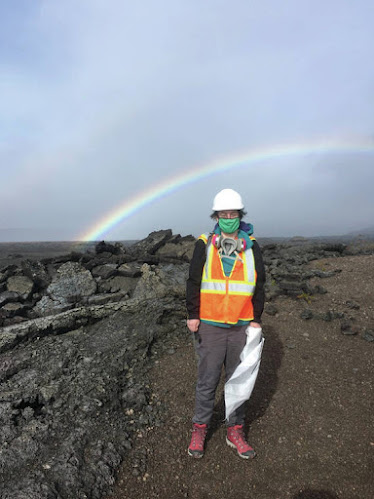 |
| This old Ninole bridge was replaced in recent years along Hwy 11, mauka of Punalu'u. State DOT photo |
REPAIRING AND IMPROVING BRIDGES IN HAWAI'I is the aim of funding announced on Friday by U.S. Sen. Brian Schatz. He said Hawai'i will receive $339 million in new federal funding over five years with the first round totaling $67.8 million this year. He said more than 80 bridges across the islands are in need of repair or replacement.
The federal funding comes from the Department of Transportation’s newly launched Bridge Replacement, Rehabilitation, Preservation, Protection, and Construction Program, which was created by the Bipartisan Infrastructure Law passed by Congress and signed into law last November.
“This historic investment will help rebuild bridges across Hawai‘i, making them safer and more resilient for everyone,” said Schatz, Chair of the Senate Appropriations Subcommittee on Transportation and Housing. “The bipartisan infrastructure law is already helping our state, and I’m proud to have supported it.”
“This historic investment will help rebuild bridges across Hawai‘i, making them safer and more resilient for everyone,” said Schatz, Chair of the Senate Appropriations Subcommittee on Transportation and Housing. “The bipartisan infrastructure law is already helping our state, and I’m proud to have supported it.”
 |
| This old Hilea Bridge was recently replaced along Hwy 11 in Kaʻū. State DOT photo |
The program, to be administered by the Federal Highway Administration, represents the single largest dedicated bridge investment since the construction of the interstate highway system – providing $26.5 billion to states, the District of Columbia and Puerto Rico over the five years of the law and $825 million for Tribal transportation facilities. The total amount that will be available to states, D.C. and Puerto Rico in Fiscal Year 2022 is $5.3 billion, along with $165 million for tribes.
The Bipartisan Infrastructure Law includes an incentive for states to direct the new Bridge Formula Program funds to off-system bridges owned by a county, city, town or other local agency. While states normally must match federal funding with up to 20 percent state or local funding, the guidance issued today notes that federal funds can be used for 100 percent of the cost of repairing or rehabilitating such locally owned off-system bridges.
HVO quickly released information to the public thanks to Katie Mulliken, another RCUH scientist who specializes in public communication. Mulliken worked closely with others at HVO to raise Kīlauea's Volcano Alert Level prior to the eruption; she continued to put eruption information on the HVO website after the eruption started to keep Hawaiʻi Volcanoes National Park staff and the public informed. The entire event from first detection to eruption unfolded in less than forty-five minutes.
Real-time monitoring, forecasting and detecting eruptive activity is a major part of HVO's mission, along with informing the public of changes in activity. But there are other important HVO responsibilities including data collation, documenting activity, and historical analysis that cooperative projects with UHH/CSAV help HVO accomplish.
Lil DeSmither and Miki Warren are two other RCUH employees who participate in crucial projects at HVO. DeSmither is often part of the geology field crews; she's gained experience by routinely monitoring volcanic activity during the Pu'u'ō'ō, 2018 lower East Rift Zone, and recent Kīlauea summit eruptions. In the field, DeSmither measures Halema'uma'u lava lake, lava fountain heights, and other features using a laser rangefinder. She also helps collect, organize, post, and archive visual and thermal photographs and videos during helicopter overflights. These products are then used to create eruption maps, Digital Elevation Models (DEMs), and eruption chronologies.

The Bipartisan Infrastructure Law includes an incentive for states to direct the new Bridge Formula Program funds to off-system bridges owned by a county, city, town or other local agency. While states normally must match federal funding with up to 20 percent state or local funding, the guidance issued today notes that federal funds can be used for 100 percent of the cost of repairing or rehabilitating such locally owned off-system bridges.
 |
| Lil DeSmither uses a thermal imaging infrared camera to measure surface temperatures on a cracked road with steam coming up from lava. USGS photo |
Real-time monitoring, forecasting and detecting eruptive activity is a major part of HVO's mission, along with informing the public of changes in activity. But there are other important HVO responsibilities including data collation, documenting activity, and historical analysis that cooperative projects with UHH/CSAV help HVO accomplish.
Lil DeSmither and Miki Warren are two other RCUH employees who participate in crucial projects at HVO. DeSmither is often part of the geology field crews; she's gained experience by routinely monitoring volcanic activity during the Pu'u'ō'ō, 2018 lower East Rift Zone, and recent Kīlauea summit eruptions. In the field, DeSmither measures Halema'uma'u lava lake, lava fountain heights, and other features using a laser rangefinder. She also helps collect, organize, post, and archive visual and thermal photographs and videos during helicopter overflights. These products are then used to create eruption maps, Digital Elevation Models (DEMs), and eruption chronologies.
 |
| Miki Warren conducts most of USGS' S02 emission rate measurements. UH photo |
Warren conducts the majority of Kīlauea's sulfur dioxide (SO2) emission rate measurements—one of the most critical gas datasets at HVO. Sulfur dioxide emissions inform us about eruption intensity and potential for vog (volcanic air pollution) in communities downwind. Miki also calculates the height of the summit volcanic gas plume from camera imagery and assists with water sampling, gas sampling, and other gas measurement campaigns.
Several RCUH postdoctoral researchers at HVO work on projects related to volcanic ash deposits, volcanic plumes, and lava flow modeling. HVO is also in the process of bringing a ground deformation specialist on board through RCUH. The cooperative agreement has also supported Dr. Cheryl Gansecki and Dr. Steven Lundblad's real-time geochemistry lab at UHH that played an important role in monitoring the 2018 eruption.
These current RCUH employees are just a small sample of the many RCUH staff that have aided HVO over the years. The dedication and passion that the RCUH employees bring to work every day contributes to HVO's mission and several RCUH employees have gone on to have careers with the USGS.
Collaborative and cooperative work between USGS and RCUH staff enhances data acquisition, hazard assessments, and information distribution at HVO. At times, this work is difficult and can go unnoticed, but it is vital to volcano and earthquake monitoring in Hawai'i. USGS and RCUH staff at HVO, with diverse backgrounds, and specialties, work together to accomplish our mission at the highest possible level.
Several RCUH postdoctoral researchers at HVO work on projects related to volcanic ash deposits, volcanic plumes, and lava flow modeling. HVO is also in the process of bringing a ground deformation specialist on board through RCUH. The cooperative agreement has also supported Dr. Cheryl Gansecki and Dr. Steven Lundblad's real-time geochemistry lab at UHH that played an important role in monitoring the 2018 eruption.
These current RCUH employees are just a small sample of the many RCUH staff that have aided HVO over the years. The dedication and passion that the RCUH employees bring to work every day contributes to HVO's mission and several RCUH employees have gone on to have careers with the USGS.
Collaborative and cooperative work between USGS and RCUH staff enhances data acquisition, hazard assessments, and information distribution at HVO. At times, this work is difficult and can go unnoticed, but it is vital to volcano and earthquake monitoring in Hawai'i. USGS and RCUH staff at HVO, with diverse backgrounds, and specialties, work together to accomplish our mission at the highest possible level.
To read comments, add your own, and like this story, see www.facebook.com/kaucalendar/. See latest print edition at www.kaucalendar.com.
COVID COUNTS STATEWIDE SWANG WILDLY OVER THE WEEKEND. The highest daily count of new cases to date reached 5,997 on Saturday and declined to 3,787 on Sunday.
In the last 14 days the number of cases from Volcano through Ocean View were 19 in Volcano, 20 in Pāhala, 23 in Nāʻālehu and 13 in Ocean View. The state Department of Health reported a positivity rate for Hawai'i Island on Friday at 18.1 percent, which is a decline. Continued decline over the next week or two could indicate that perhaps the disease has reached its peak and may drop away in the near future.
To read comments, add your own, and like this story, see www.facebook.com/kaucalendar/. See latest print edition at www.kaucalendar.com.
A SCAM SEEKING SOCIAL SECURITY AND LICENSE PLATE NUMBERS has drawn a warning from the state Department of Transportation. DOT reports that the phishing link comes via an email from profileinfos@hat.kr and stays, “You have an incomplete Hawaii DMV contact informations on your Hawaii Department of Motor Vehicle."To read comments, add your own, and like this story, see www.facebook.com/kaucalendar/. See latest print edition at www.kaucalendar.com.

 |
| See archives of The Ka`u Calendar at www.kaucalendar.com and find the monthly print copy in mailboxes from Volcano through Ocean View. |






















